The use of a euryhaline Tilapia to assess the endocrine disrupting effects of anthropogenic chemicals on growth and osmoregulation of a tropical teleost species inhabiting coastal waters and wetlands in Hawaiʻi and the tropics
PRINCIPAL INVESTIGATOR: Andre Seale

Many agricultural and industrial chemicals have demonstrated the capacity to disrupt the physiology of wildlife by impacting the endocrine system. These man-made substances, termed endocrine disrupting chemicals (EDCs), cause immediate physiological effects or can lead to long-term developmental changes especially in aquatic organisms. EDC’s include hormones, pharmaceuticals, pesticides, plasticizers, and other organic compounds that are in streams and near-shore waters in the US, including Hawaiʻi. Among the most pervasive EDCs in the aquatic environment are 17-beta estradiol (E2), and its synthetic analogue ethinyl estradiol (EE2), which are widely used in contraceptives and excreted via urine into the aquatic environment. Other chemicals, notably nonylphenol (NP), dichlorodiphenyltrichloroethane (DDT), and chlordane (and other pesticides) are also widespread in the environment, particularly in Hawaiʻi, and have been shown to alter the reproductive physiology of fish. The proper management of pesticide use and water resources, therefore, are critical for mitigating the effects of waterborne EDCs on aquatic wildlife. While much is known about the impacts of EDCs in temperate fish species, little work has focused on tropical species. To that extent, it is critical to understand the integrated physiological and developmental effects of EDCs in a warm-water, euryhaline species. Hence, we propose to characterize the effects of EDCs widely found in Hawaiʻi on the major endocrine parameters associated with the regulation of the growth and the salt and water balance in the warm water euryhaline tilapia, Oreochromis mossambicus. We shall employ tilapia acclimated to either fresh water (FW) or seawater (SW) as a tropical fish model to characterize the effects of E2, EE2, NP, DDT and chlordane on endocrine parameters of growth and osmoregulation utilizing a combination of in vivo and in vitro approaches.
Watch a podcast on this project here.

